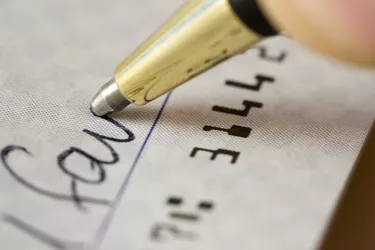
MICR is shorthand for "magnetic ink character recognition." It's a form of magnetic print technology that machines can use to read and record information. It's effectively a form of magnetic-sensitive ink that's used in check printing along with special MICR fonts to ascertain whether a paper document is legitimate. This technology isn't unique to the U.S. Many countries use it, predominantly in the banking industry.
What Do MICR Numbers Mean?
Video of the Day
Your bank's routing number and your account number are printed on your check using MICR technology. The first nine digits are usually the routing number, followed by a space. Your account number, usually 12 digits, typically comes after the space.
Video of the Day
Both the routing number and your account number should be clearly visible on a check so the check can be honored and paid, but banking institutions can change the order in which they appear, and they can include additional information. Your check number might also appear on the right side of the line, according to the Cornell Law School Legal Information Institute.
Where Does MICR Appear?
MICR numbers appear on the bottom of a check and are often referred to as the MICR line. They must be printed within less than an inch of the bottom edge of the check – 0.625 of an inch to be exact, according to Relyco. No other artwork or printing can appear in this area.
The font matters, too, according to Defit.org. The E-13B font is the international standard, although some European nations use CMC-7.
How Does MICR Work?
The MICR information is recognized and read by the sorting machines that all checks are processed through when they're received by a banking institution. A sensor records the routing number and the account number and any other information that's provided, then it sends the check to the issuing bank for final processing and payment.
The MICR reader/sensor can see through any writing or stamp marks that might otherwise blur the MICR for interpretation. The sensor magnetizes the MICR ink, then translates the information into characters. The ink isn't actually charged until it reaches the sorter. The machine magnetizes it for readability.
Benefits and Drawbacks of MICR
MICR significantly speeds up check processing. It's handled by central processing systems at the end of each banking day. But it's not so technologically advanced that it depicts information that can't be read and processed by the human eye, so it doesn't eliminate the possibility of check fraud entirely.
But MICR is also virtually tamper-proof, so it is fraud-resistant to a great extent. The numbers and images that appear can't be altered or changed in any way by anything other than the original MICR printer.
The required fonts and the MICR line placement on the check must share the same characteristics and be universal, according to the American National Standards Institute. ANSI sets these guidelines. Sorter machines everywhere must be able to recognize and identify the ink.
Mistakes in MICR printing can seriously delay the processing of checks or prevent processing and payment completely in some cases. A check could bounce regardless of whether sufficient money is present in the account to cover it. It would most likely be paid eventually, but the financial institution would have to process it manually.
Common Questions
Who Created the MICR?
The American Bankers Association, familiarly known as ABA, is credited with developing MICR in 1958 to combat issues of check fraud. ANSI – the American National Standards Institute – adopted MICR some years later, according to the Troy Group.
What Is an Example of an MICR?
Most MICR lines look like this in the U.S.:
123456789 (the bank's routing number) followed by 101112131415 (the account number), then ABCD (the check number) with spaces in between each set of numbers. It would ultimately appear as: 123456789 101112131415 ABCD.
The first check drawn on an account might appear as 0001. The 100th check drawn on the account would show as 0100.
- Defit.org: Magnetic Ink Character Recognition
- American National Standards Institute: MICR External Processing Code (EPC), ANSI X9.100-1602-2020
- Cornell Law School Legal Information Institute: Magnetic Ink Character Recognition Line
- Troy Group: MICR Basics Handbook
- Relyco: History of MICR – Magnetic Ink Character Recognition